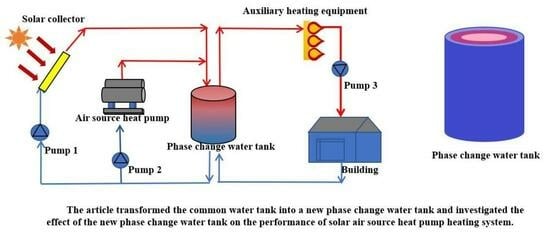Simulation Study of a Novel Solar Air-Source Heat Pump Heating System Based on Phase-Change Heat Storage
Abstract
:1. Introduction
2. Concept of the System
- The solar collector operates alone.
- The air-source heat pump operates alone.
- The solar collector and the air-source heat pump operate together.
2.1. Phase-Change Water Tank
2.2. Specific Parameters of Other Components
3. Construction of System Model
3.1. Mathematical Models
3.2. Simulation Validation
- As the core equipment of the heating system in this study, the models of the ETC, ASHP, and phase-change water tank were verified. Han et al. [27] conducted an experimental study on a solar water heating system in Tianjin and tested the daily useful heat of an ETC. The meteorological parameters of the ETC and water tank were set in the traditional ASAHPHS in this study. The ASHP loop and the heating loop in the traditional heating system were closed, and then the solar heat collection loop was simulated. At different initial temperatures of the tank, the experimental and simulated values of the useful heat of the collector were compared, as shown in Figure 3. It can be clearly seen that the variation trend of the simulated value was consistent with that of the experimental value, and the relative error between them was 4.89% at most.
- Jin et al. [28] conducted a separate air-source heat pump heating test in Baotou. The solar heat collecting loop and auxiliary heating equipment in the traditional system in this paper were closed, and relevant parameters (weather, air-source heat pump, etc.) in the experiment were set in the system model in this paper for simulation. The experimental and simulated values of the temperature difference between the inlet and outlet of the ASHP are shown in Figure 4a. Figure 4b shows the comparison between the experimental values and the simulated values of COP of the ASHP. As can be seen from Figure 4, the experimental values and simulated values had the same variation trend, but there were still errors between them. All relative errors were kept within ±9%.
- Man [29] investigated the thermal performance of a phase-change water tank under the climatic conditions of Jinzhou. The phase-change water tank designed by Man [29] had an inner diameter of 75 cm, an outer diameter of 90 cm, and a phase-change layer thickness of 15 cm. The tank was filled with myristic acid as the PCM. The parameters of the water tank and PCM in [29] were set in the model of the phase-change water tank in this paper to verify the heat storage and release of the phase-change water tank. As can be seen from Figure 5, during the heat storage and release process, the change trend of PCM temperature was consistent with the literature. However, there was still a difference in temperature, which was within a 10 percent margin of error.
- According to the variation trend of the above parameters and the range of relative errors, the results of the component model established in this paper can be considered to be reliable. The reasons for the error may be the instability of meteorological parameters (wind change and cloud change in the experiment), the initial temperature fluctuation of the tank, the heat loss of the pipeline, and the operation of the system.
3.3. Heat Load Simulation
3.4. Heating System Model Establishment and Control Strategy
4. Analysis of Results
4.1. Collector Efficiency
4.2. Performance of ASHP
4.3. Phase-Change Water Tank
4.4. System Energy Consumption
5. Conclusions
- The incorporation of a PCM significantly enhanced the temperature difference between the inlet and outlet of the solar collector in the heating system, thereby further augmenting its useful energy output. As a result, compared to the heating system without the PCM, the phase-change heating system exhibited an average heat collection efficiency of 45.8% throughout the entire heating period—an improvement of 5.9%. This demonstrated a more comprehensive and effective utilization of solar energy. Under identical load conditions, the phase-change system reduced the heating capacity requirement by 810.82 kWh while slightly decreasing the COP of the ASHP.
- Compared with the traditional system, the improved phase-change heating system was more rational in the distribution of heat. The existence of the PCM alleviated the temperature drop of the auxiliary heating measurement, so the electric heating capacity of 169.55 kWh was saved. The phase-change heat storage system reduced the total energy consumption by 484.91 kWh during the whole heating operation, which had a great energy-saving advantage.
- The addition of phase-change heat storage technology offered a more stable heat source to the PCM-based heating system. Additionally, the manufacturing of the phase-change water tank was relatively simple, and the processing technology of the water tank was fairly mature. So, the phase-change heating system in this paper could be well developed.
Author Contributions
Funding
Institutional Review Board Statement
Informed Consent Statement
Data Availability Statement
Acknowledgments
Conflicts of Interest
Nomenclature
| SASHPHS | solar air-source heat pump heating system |
| SC | solar collector |
| SAHP | air-source heat pump |
| COP | coefficient of performance |
| PCM | phase-change material |
| MA | myristic acid |
| EG | expanded graphite |
| ETC | evacuated tube collector |
| Qu | the useful thermal energy of the fluid |
| η | efficiency of the solar collector |
| Q | the heat storage of the phase-change water tank |
| Qd | the useful thermal energy of the fluid during the day |
| Ttank | initial water temperature of the tank |
| TASHP-OUT | outlet water temperature of the air-source heat pump |
| TASHP-IN | inlet water temperature of the air-source heat pump |
References
- Jiang, Y. Annual Report on China Building Energy Efficiency; China Architecture and Building Press: Beijing, China, 2011. [Google Scholar]
- Ma, H.T.; Du, N.; Yu, S.J. Analysis of typical public building energy consumption in northern China. Energy Build. 2017, 136, 139–150. [Google Scholar] [CrossRef]
- Wang, F.L.; Liu, X.; Jiang, B.H.; Zhuo, H.; Chen, W.; Chen, Y.; Li, X. Low-loading Pt nanoparticles combined with the atomically dispersed FeN sites supported by Fe-N-C for improved activity and stability towards oxygen reduction reaction/hydrogen evolution reaction in acid and alkaline media4SA. J. Colloid Interface Sci. 2023, 635, 514–523. [Google Scholar] [CrossRef] [PubMed]
- Li, Q.C.; Zhao, D.F.; Yin, J.K.; Zhou, X.; Li, Y.; Chi, P.; Han, Y.; Ansari, U.; Cheng, Y. Sediment Instability Caused by Gas Production from Hydrate-bearing Sediment in Northern South China Sea by Horizontal Wellbore: Evolution and Mechanism. Nat. Resour. Res. 2023, 8, 1–26. [Google Scholar] [CrossRef]
- Aytac, A.; Seckin, K. Investigation of the effect of decomposition methods on wind speed forecasting model performance defined by deep learning algorithm. Eur. J. Sci. Technol. 2020, 20, 844–853. [Google Scholar]
- Mekhilef, S.; Saidur, R.; Safari, A. A review on solar energy use in industries. Renew. Sustain. Energy Rev. 2011, 15, 1777–1790. [Google Scholar] [CrossRef]
- Hawlader, M.N.A.; Chou, S.K.; Ullah, M.Z. The performance of a solar assisted heat pump water heating system. Appl. Therm. Eng. 2003, 21, 1049–1065. [Google Scholar] [CrossRef]
- Huang, B.J.; Lee, C.P. Long-term performance of solar-assisted heat pump water heater. Renew. Energy 2004, 29, 633–639. [Google Scholar] [CrossRef]
- Kuang, Y.H.; Sumathy, K.; Wang, R.Z. Study on a direct-expansion solar-assisted heat pump water heating system. Int. J. Energy Res. 2003, 27, 531–548. [Google Scholar] [CrossRef]
- Zhan, H.; Wu, R.H.; Yu, H. Load analysis and area optimization of Solar heat pump system for daytime heating. J. Eng. Therm. Energy Power 2022, 37, 124–130. [Google Scholar]
- Zeng, N.H.; Yuan, Y.P.; Sun, L.L. Optimization on air source heat pump assisted solar water heating system based on TRNSYS. Acta Energ. Sol. Sin. 2018, 39, 1245–1254. [Google Scholar]
- Wang, H.W.; Zhu, B.; Wu, D.M. Research on multi-regional applicability of solar energy-assisted air source heat pump system. Therm. Power Gener. 2022, 51, 18–26. [Google Scholar]
- Guo, C.M.; Xu, W.L.; Wang, Y. Experimental research on domestic hot water for solar energy-air source heat pump composite system in Guangdong. Therm. Sci. Technol. 2020, 19, 177–184. [Google Scholar]
- Sterling, S.J.; Collins, M.R. Feasibility analysis of an indirect heat pump assisted-solar domestic hot water system. Appl. Energy 2012, 93, 11–17. [Google Scholar] [CrossRef]
- Dikici, A.; Akbulut, A. Performance characteristics and energy-exergy analysis of solar-assisted heat pump system. Build. Environ. 2008, 43, 1961–1972. [Google Scholar] [CrossRef]
- Sun, Y.T.; Jiang, L.L.; Fan, W.Y. Research of solar air source heat pump system based on phase change energy storage. Renew. Energy Resour. 2021, 39, 169–174. [Google Scholar]
- Yan, S.Y.; Wang, Q.; Gao, S.J. Optimization of air source heat pump-solar hybrid heating system with increased heat storage. Renew. Energy Resour. 2021, 39, 754–759. [Google Scholar]
- Qu, S.L.; Ma, F.; Jia, R. System design and energy performance of a solar heat pump heating system with dual-tank latent heat storage. Energy Build. 2015, 105, 294–301. [Google Scholar] [CrossRef]
- Zhao, M.; Gu, Z.L.; Kang, W.B. Experimental investigation and feasibility analysis on a capillary radiant heating system based on solar and air source heat pump dual heat source. Appl. Energy 2016, 185, 2094–2105. [Google Scholar] [CrossRef]
- Zhu, H.Z.; Guo, B.; Geng, W.Z. Simulation of an improved solar absorption refrigeration system with phase change materials. Energy Rep. 2022, 8, 3671–3679. [Google Scholar] [CrossRef]
- Abdelsalam, M.Y.; Teamah, H.M.; Lightstone, M.F. Hybrid thermal energy storage with phase change materials for solar domestic hot water applications: Direct versus indirect heat exchange systems. Renew. Energy 2020, 147, 77–88. [Google Scholar] [CrossRef]
- Zhang, N.; Yuan, Y.P.; Wang, X.; Cao, X.; Yang, X.; Hu, S. Preparation and characterization of lauric-myristic-palmitic acid ternary eutectic mixtures/expanded graphite composite phase change material for thermal energy storage. Chem. Eng. J. 2013, 231, 214–219. [Google Scholar] [CrossRef]
- Yang, X.J.; Yuan, Y.P.; Zhang, N.; Cao, X.; Liu, C. Preparation and properties of myristic-palmitic-stearic acid/expanded graphite composites as phase change materials for energy storage. Sol. Energy 2014, 99, 259–266. [Google Scholar] [CrossRef]
- Cao, X.L.; Yuan, Y.P.; Wang, X. Preparation and thermal property of myristic acid / expanded graphite composite as phase change material. Acta Energ. Sol. Sin. 2014, 35, 1493–1498. [Google Scholar]
- Huang, P.; Ding, Y.M.; Hu, T.; Zhang, J.; Wang, X. Study on preparation and properties of myristic-stearic acid /modified fly ash composite phase change energy storage materials. J. Funct. Mater. 2017, 48, 5154–5158. [Google Scholar]
- Wang, X.; Yuan, Y.P.; Deng, Z.H. Operating characteristic of latent heat storage water tank. Acta Energ. Sol. Sin. 2014, 35, 670–676. [Google Scholar]
- Han, K.Y.; Liu, Z.Q.; Dong, M. Analysis of influence of water temperature and value of heat storage tank on the performance of solar heat collecting system. J. Therm. Sci. Technol. 2022, 21, 373–382. [Google Scholar]
- Jin, G.; Chen, Z.H.; Guo, S.P. Heating Experimental study of solar air source heat pump system in severe cold areas. Acta Energ. Sol. Sin. 2021, 42, 251–257. [Google Scholar]
- Man, X.X. Optimization of Solar Heating System with Phase Change Heat Storage in Cold Regions. Master’s Thesis, Liaoning University of Technology, Jinzhou, China, 2021. [Google Scholar]
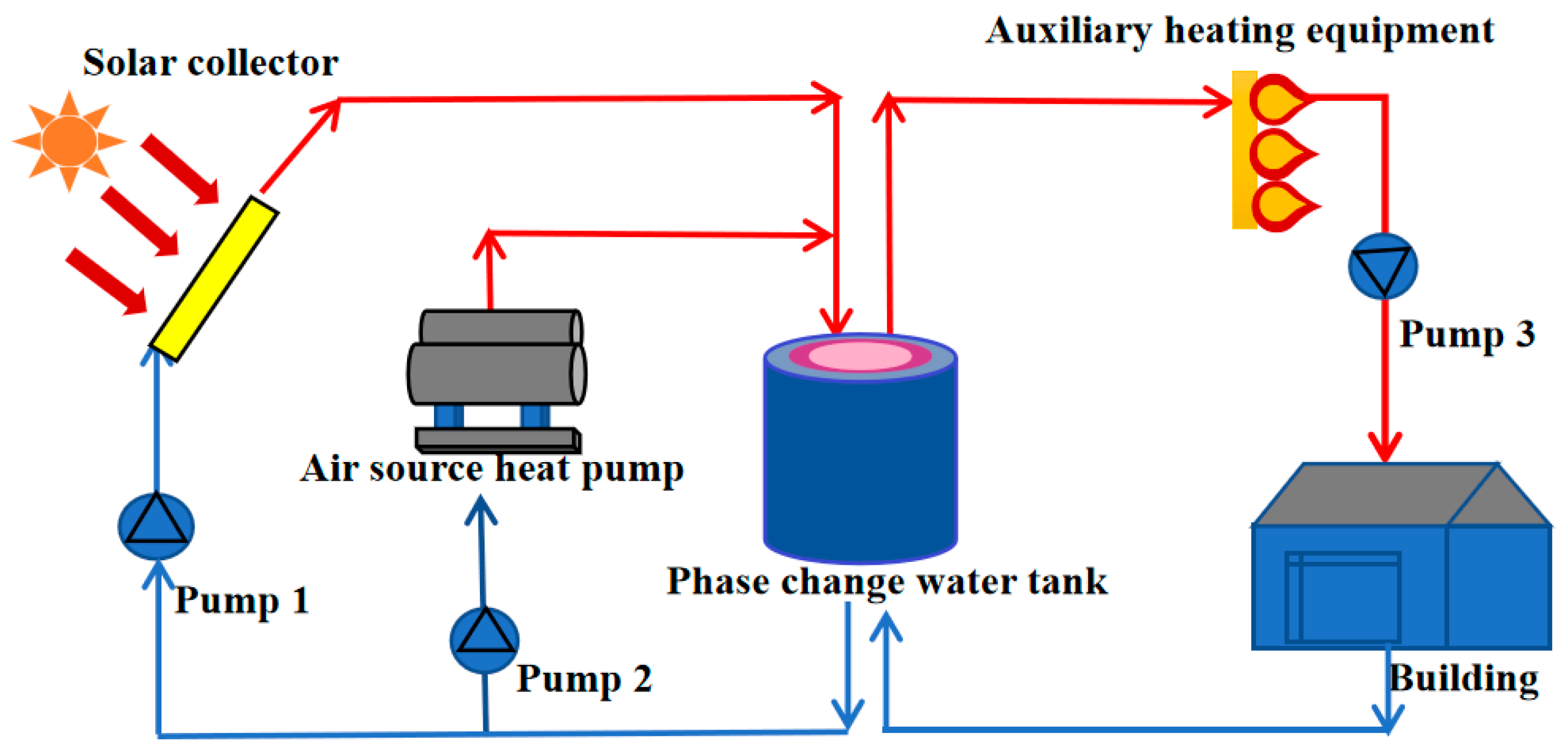
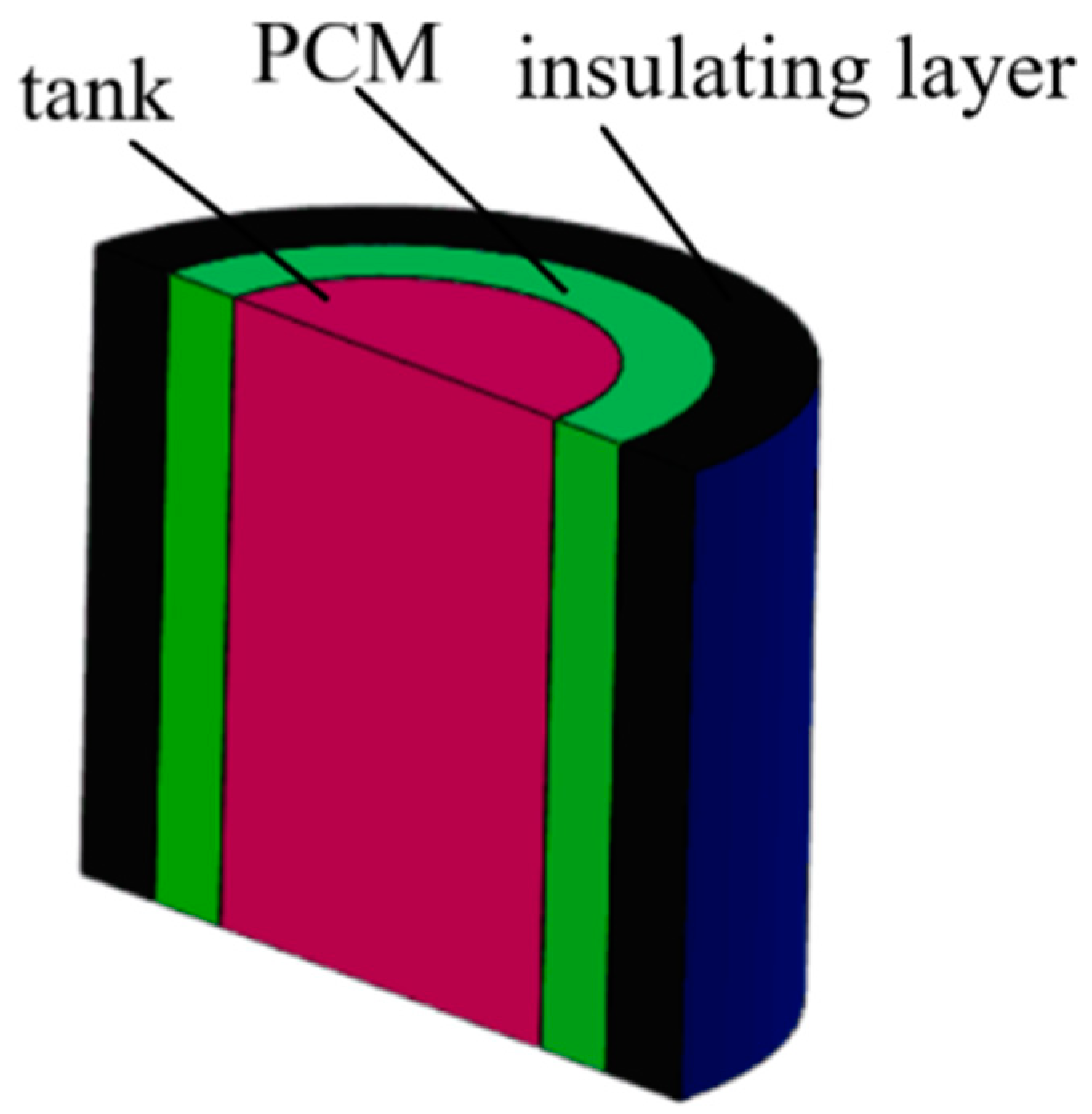
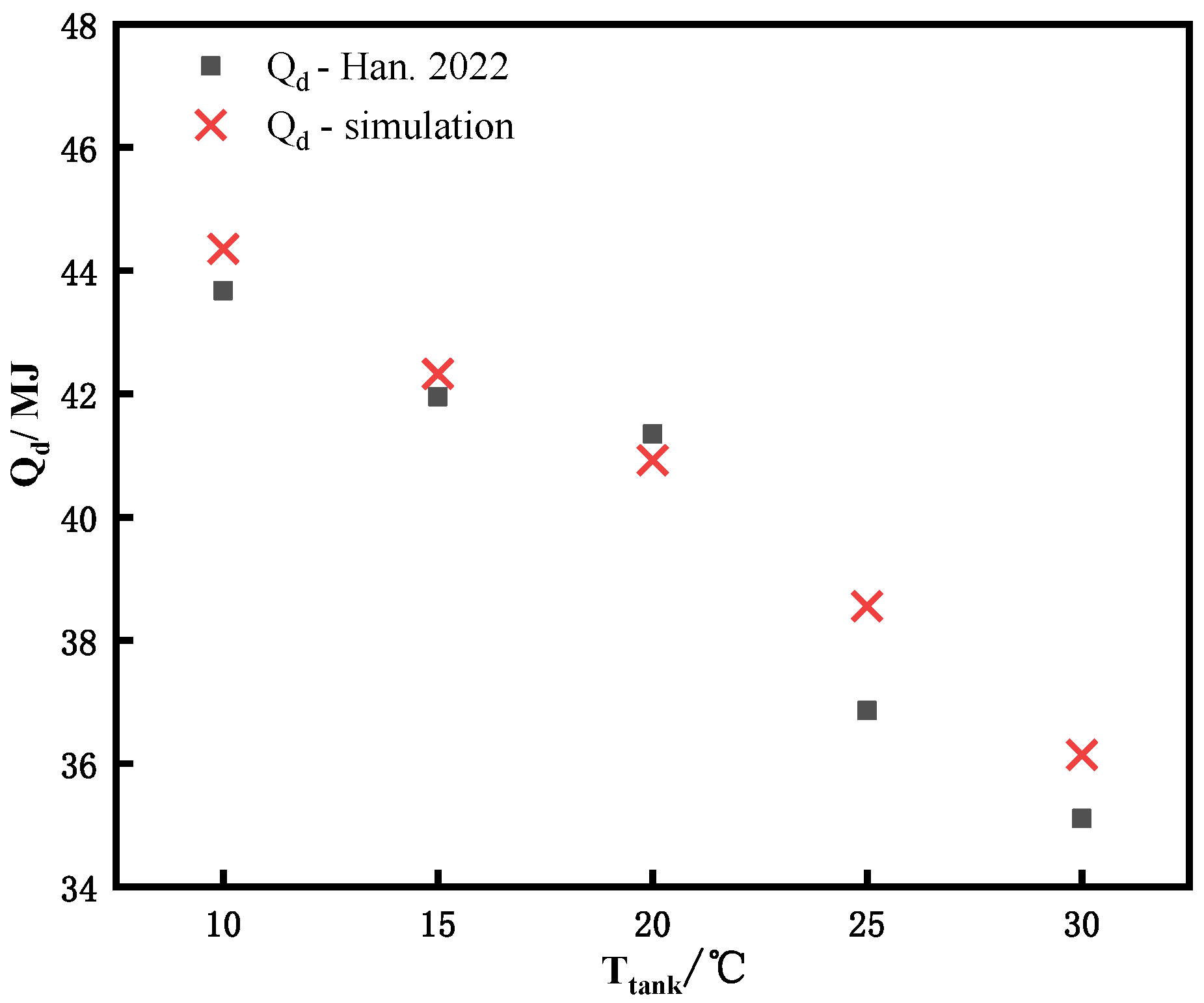
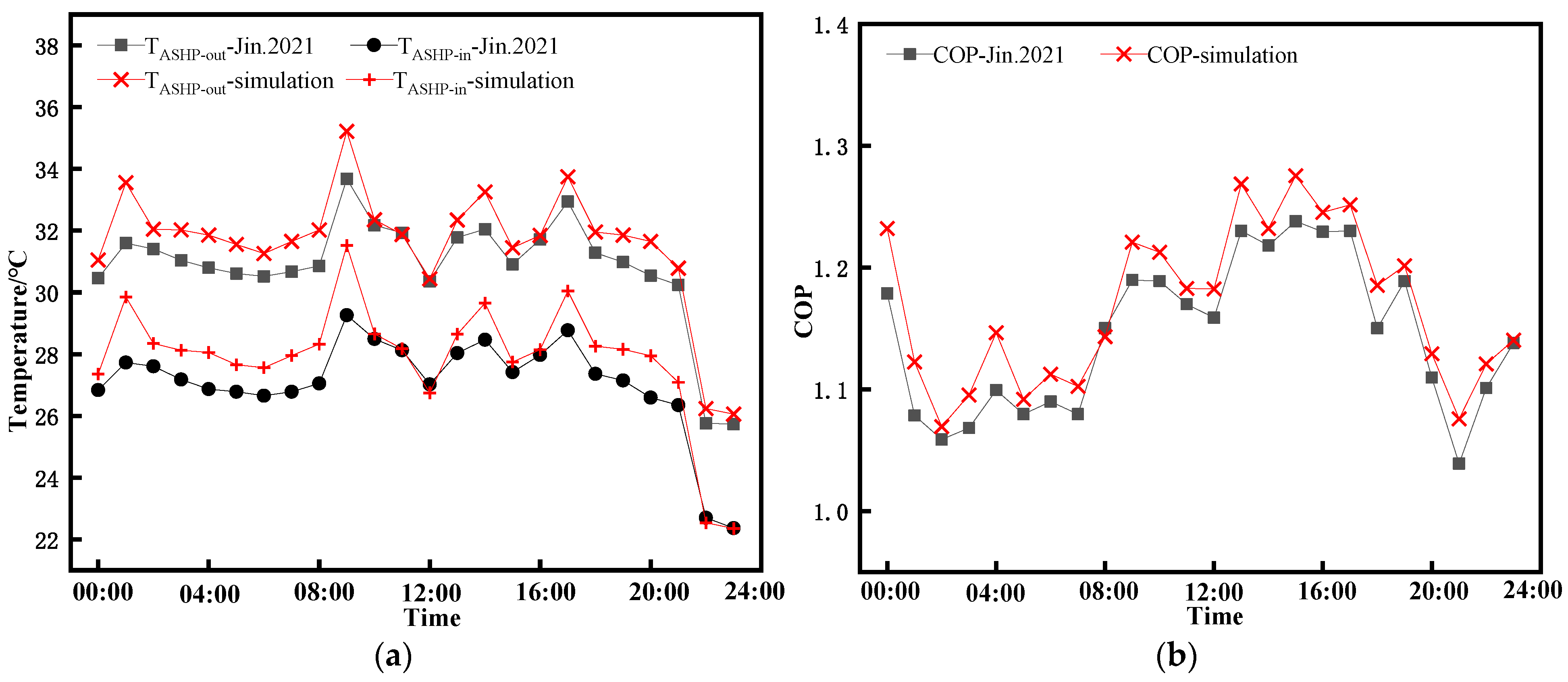

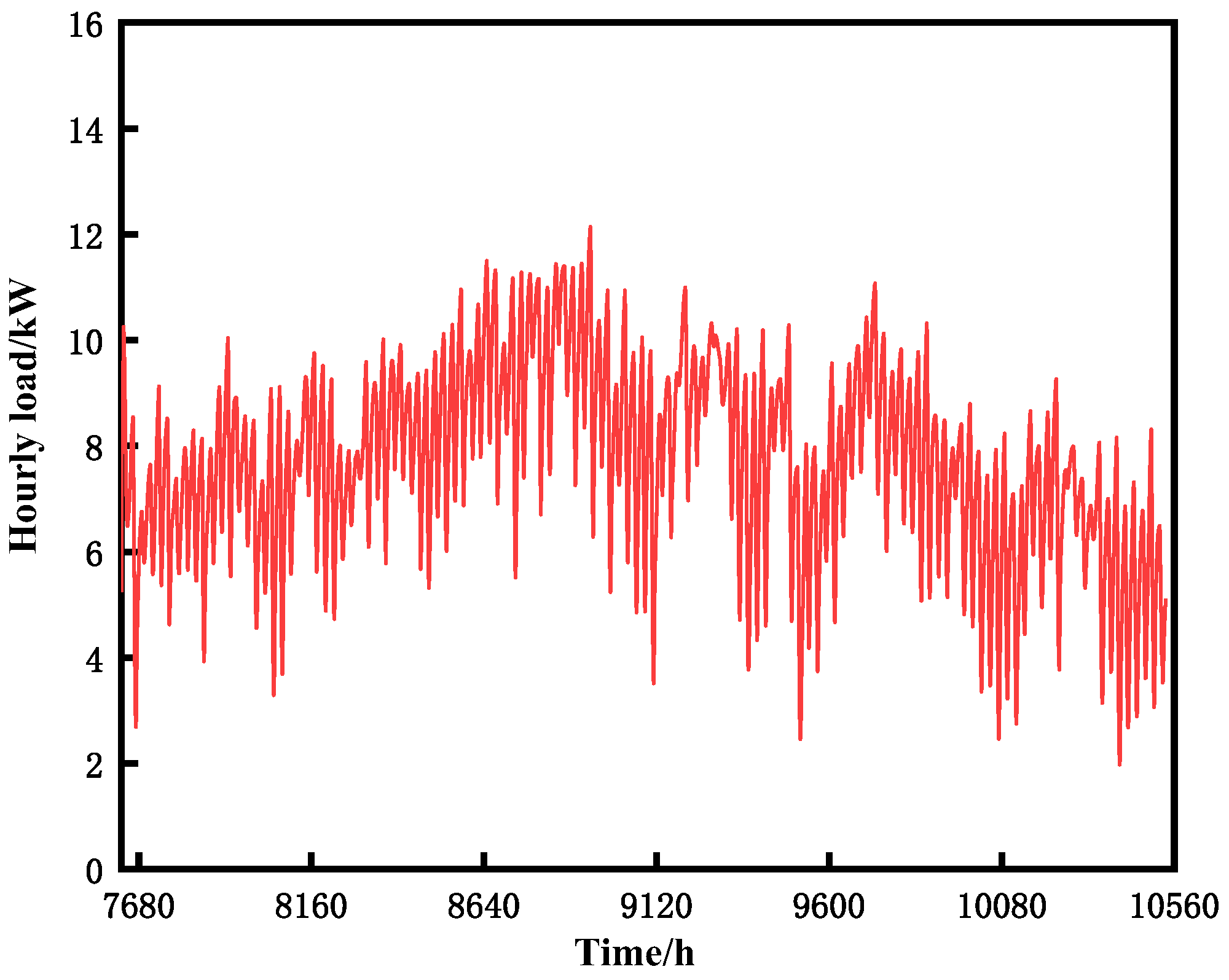
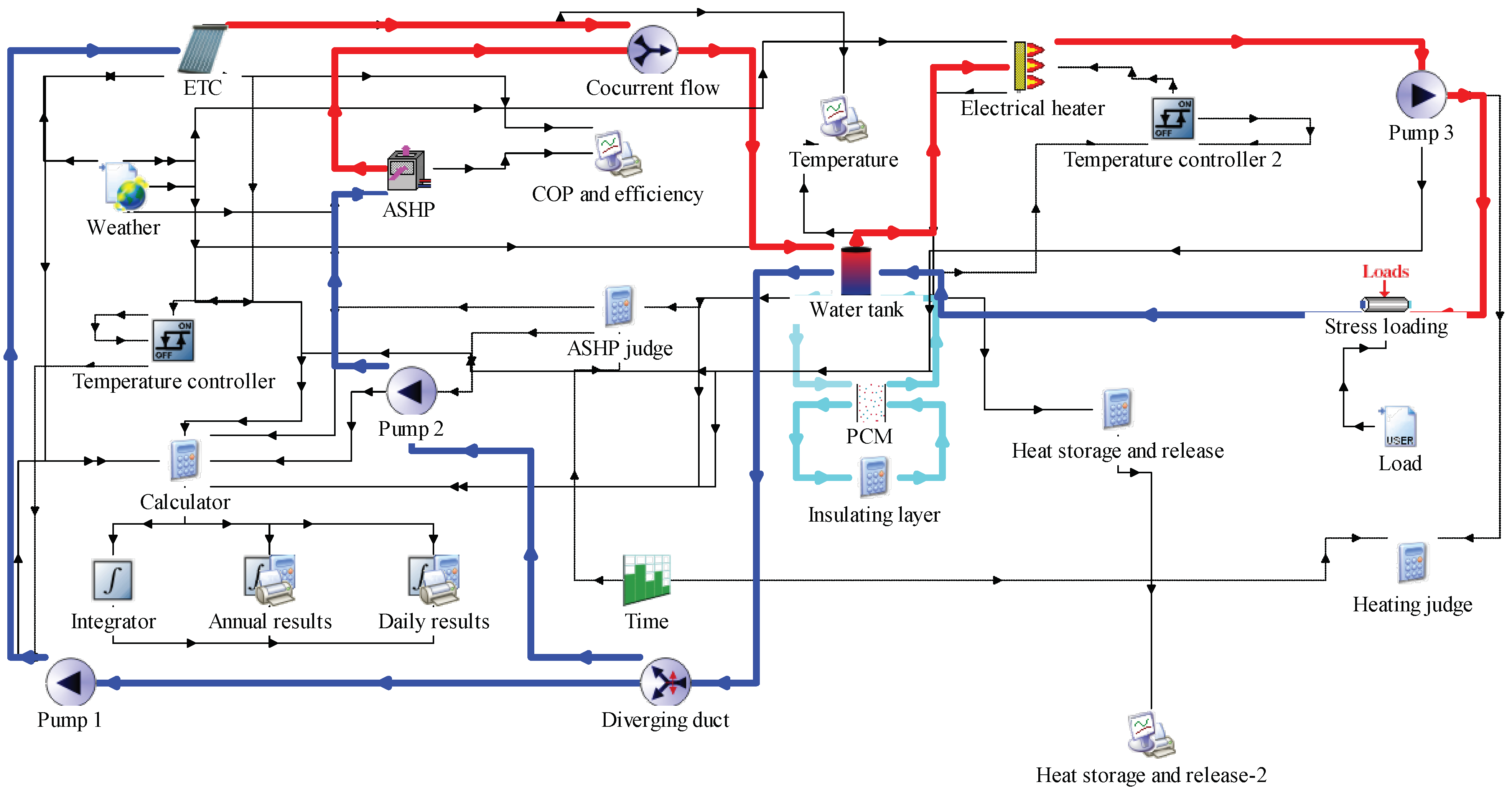
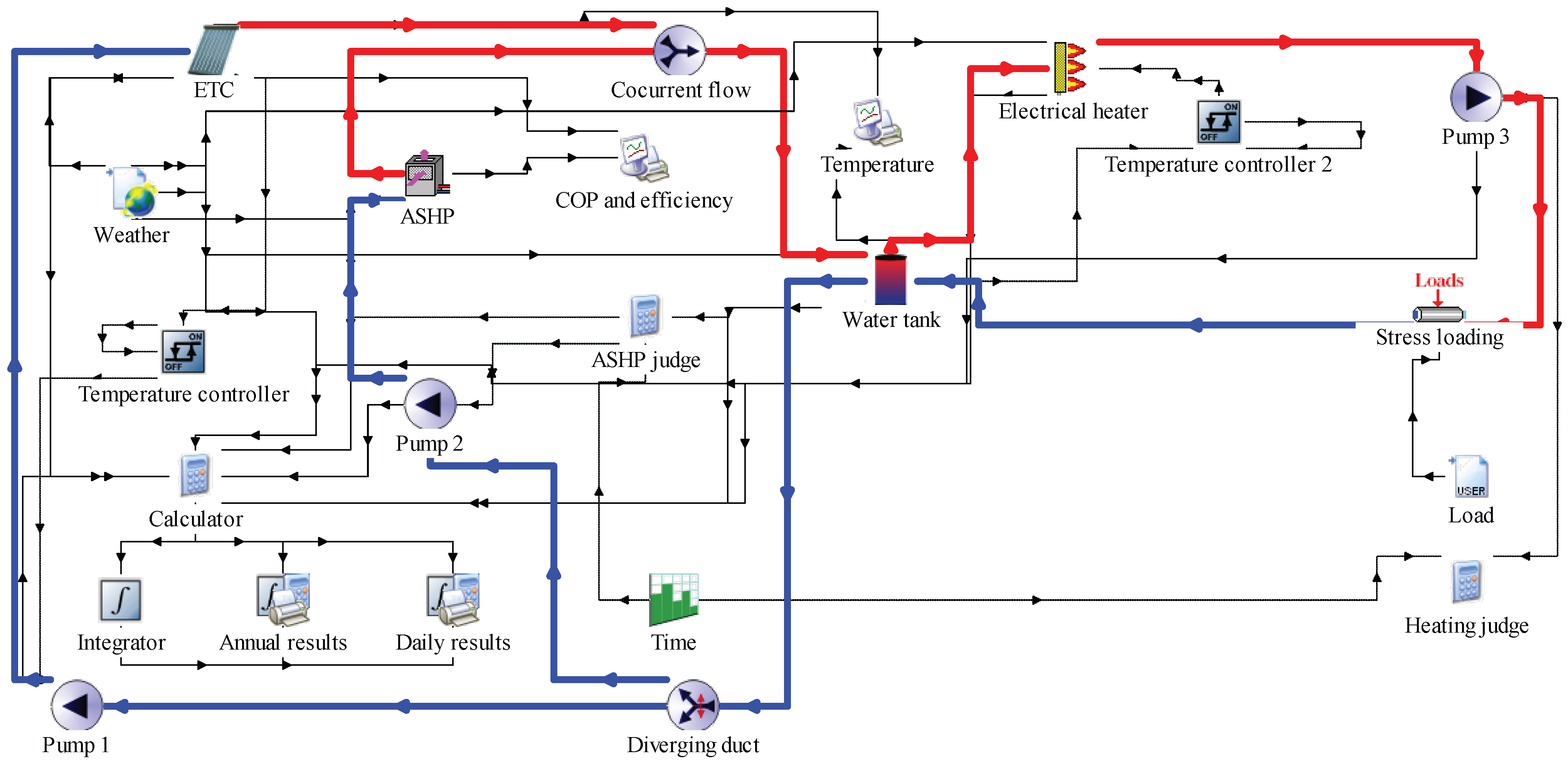
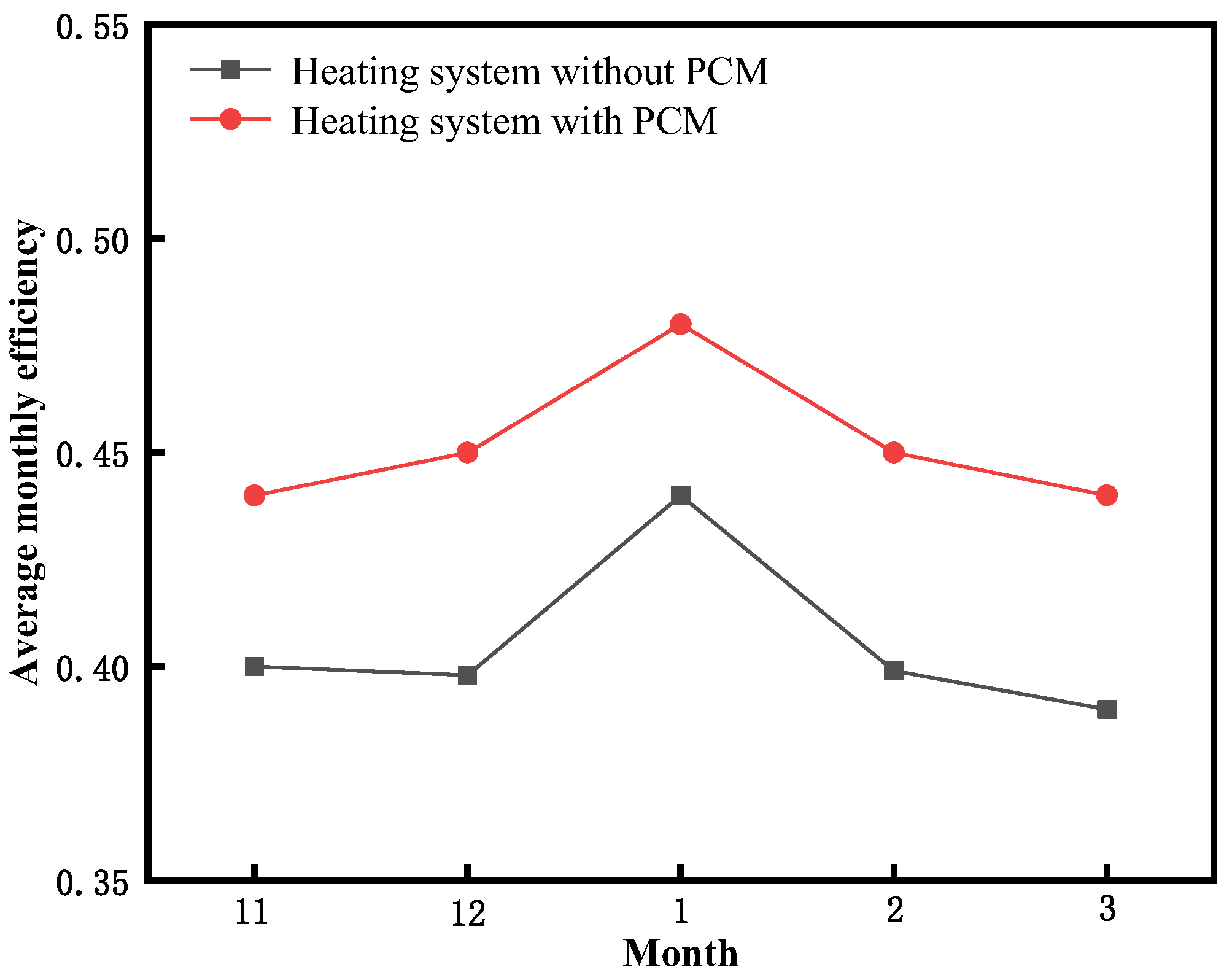

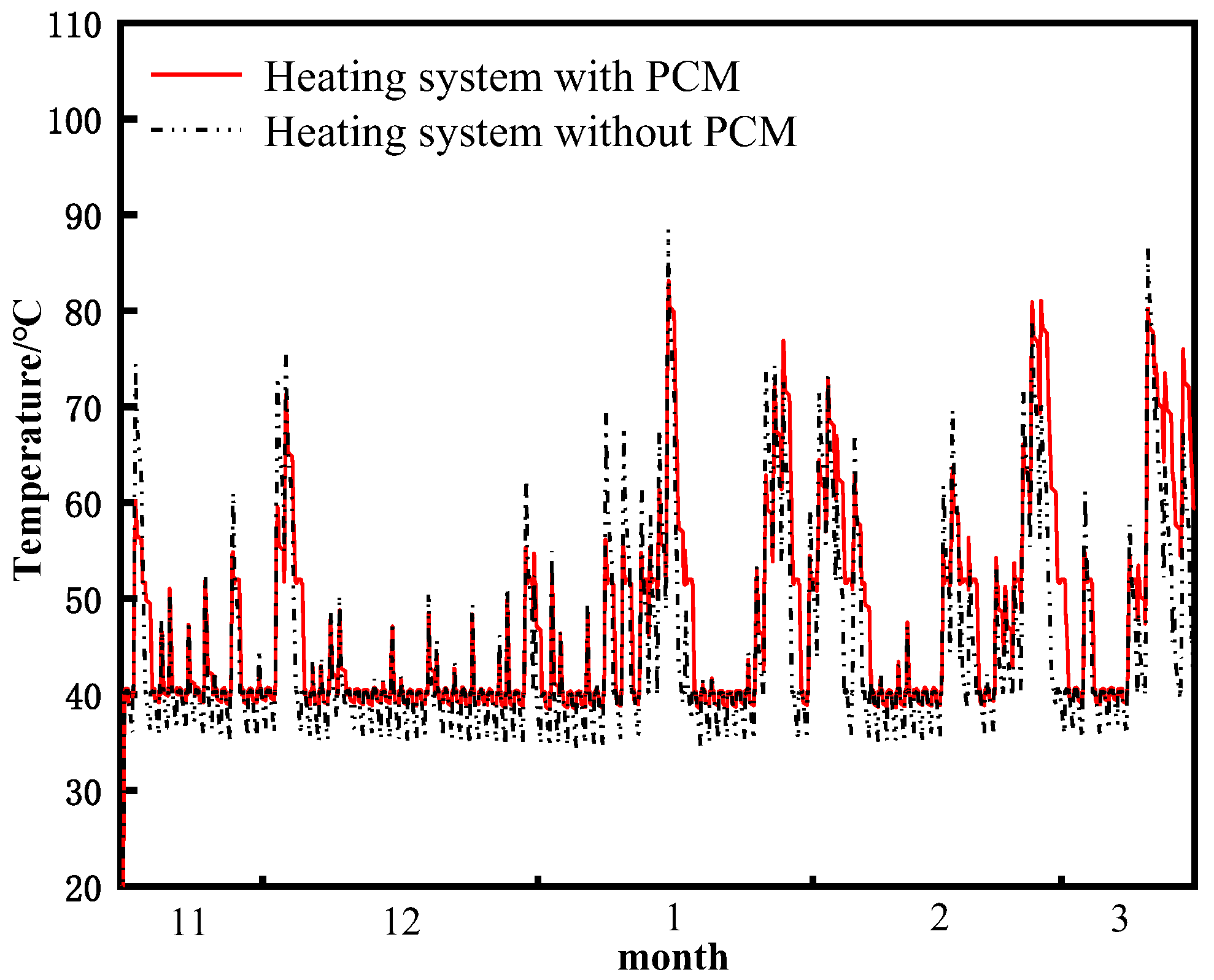
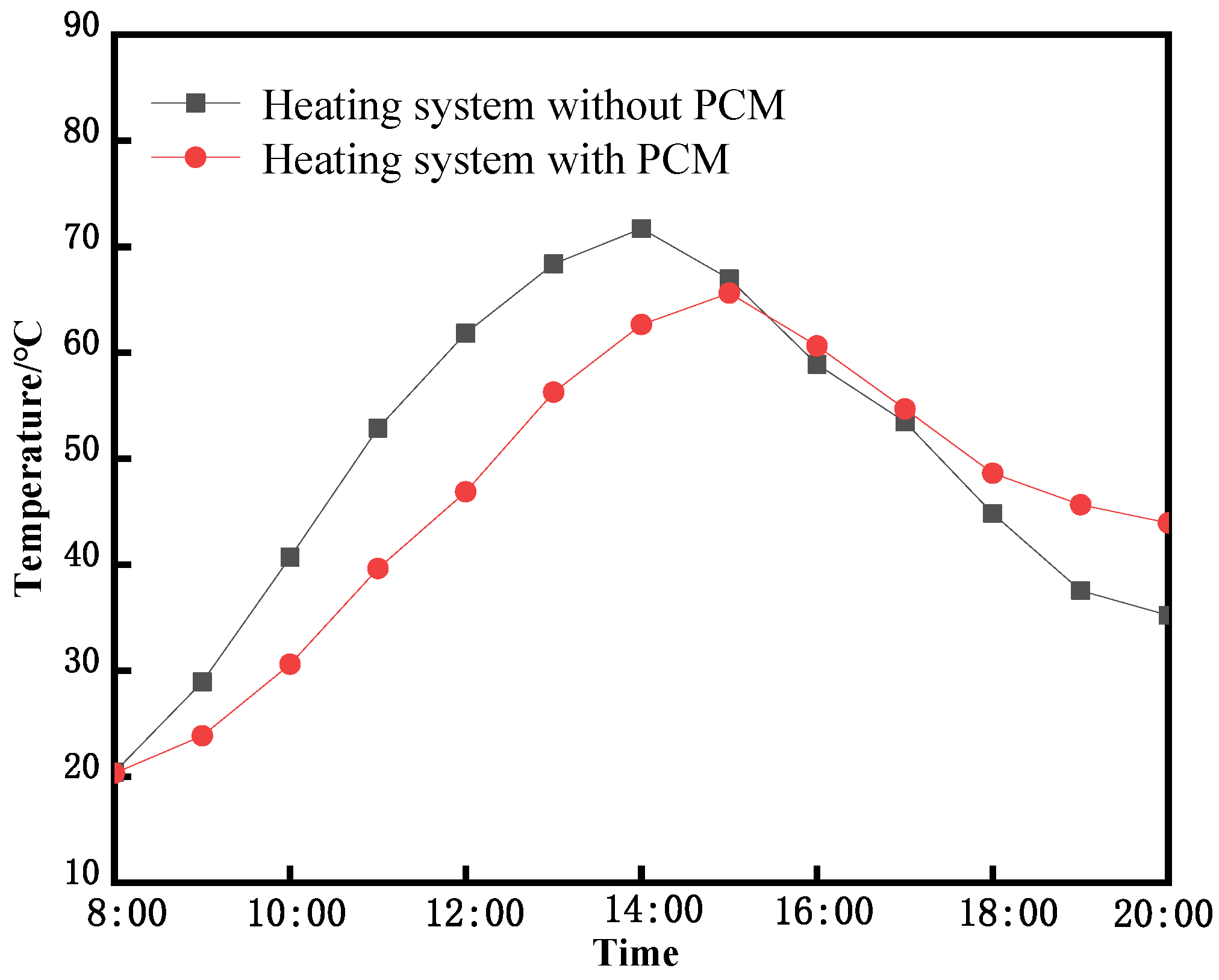
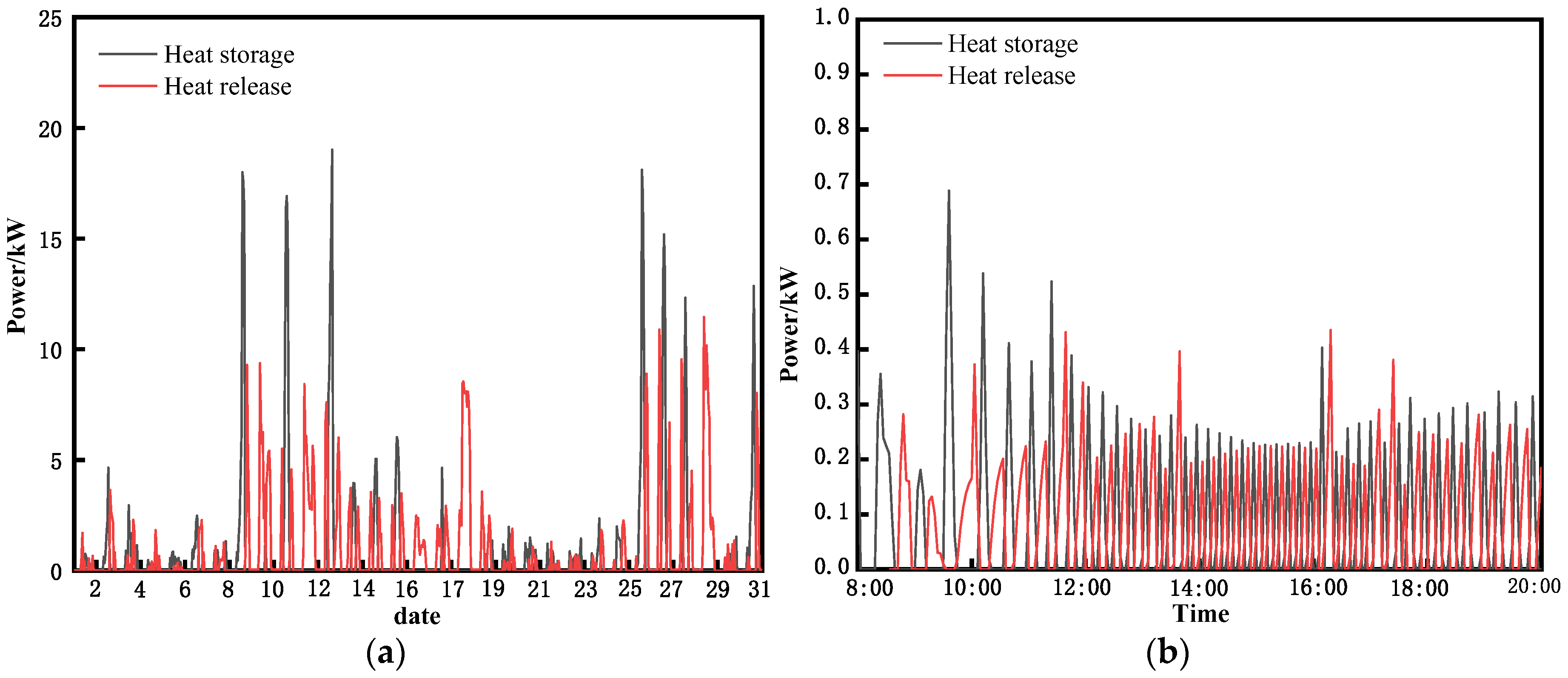
| Parameters | Numerical Value |
|---|---|
| Thermal conductivity | 0.22 W/(m·°C) |
| Phase-change temperature | 53 °C |
| Latent heat of phase change | 191.75 kJ/kg |
| Liquid specific heat capacity | 2.265 kJ/(kg·°C) |
| Solid specific heat capacity | 2.218 kJ/(kg·°C) |
| Density | 862 kg/m3 |
| Object | Type Number | Parameters |
|---|---|---|
| Solar collector | 71 | Area: 56 m2; Slope: 25°. |
| Air-source heat pump | 941 | Rated heating capacity: 12.5 kW; |
| Water tank | 158 | Volume: 3 m3. Edge loss coefficient: 1000 W/(m2·°C); Top loss coefficient: 0.6 W/(m2·°C); Bottom loss coefficient: 0.6 W/(m2·°C). |
| Phase-change layer | 1270a | Thickness: 0.12 m; Density of PCM: 862 kg/m3; Phase-change temperature: 53 °C; Latent heat of PCM: 191.75 J/g. |
| System | Useful Energy of ETC (kWh) | Total Solar Radiation (kWh) | Heating Capacity of ASHP (kWh) | Electric Heating Capacity (kWh) | Energy Consumption (kWh) |
|---|---|---|---|---|---|
| Heating system without PCM | 3955.73 | 10,149.40 | 5792.54 | 288.86 | 2749.80 |
| Heating System with PCM | 4648.02 | 10,149.40 | 4981.72 | 119.31 | 2264.89 |
Disclaimer/Publisher’s Note: The statements, opinions and data contained in all publications are solely those of the individual author(s) and contributor(s) and not of MDPI and/or the editor(s). MDPI and/or the editor(s) disclaim responsibility for any injury to people or property resulting from any ideas, methods, instructions or products referred to in the content. |
© 2023 by the authors. Licensee MDPI, Basel, Switzerland. This article is an open access article distributed under the terms and conditions of the Creative Commons Attribution (CC BY) license (https://creativecommons.org/licenses/by/4.0/).
Share and Cite
Liu, P.; Zhao, J.; Chen, J. Simulation Study of a Novel Solar Air-Source Heat Pump Heating System Based on Phase-Change Heat Storage. Sustainability 2023, 15, 15684. https://doi.org/10.3390/su152215684
Liu P, Zhao J, Chen J. Simulation Study of a Novel Solar Air-Source Heat Pump Heating System Based on Phase-Change Heat Storage. Sustainability. 2023; 15(22):15684. https://doi.org/10.3390/su152215684
Chicago/Turabian StyleLiu, Panxue, Jianhui Zhao, and Jiamei Chen. 2023. "Simulation Study of a Novel Solar Air-Source Heat Pump Heating System Based on Phase-Change Heat Storage" Sustainability 15, no. 22: 15684. https://doi.org/10.3390/su152215684
APA StyleLiu, P., Zhao, J., & Chen, J. (2023). Simulation Study of a Novel Solar Air-Source Heat Pump Heating System Based on Phase-Change Heat Storage. Sustainability, 15(22), 15684. https://doi.org/10.3390/su152215684







